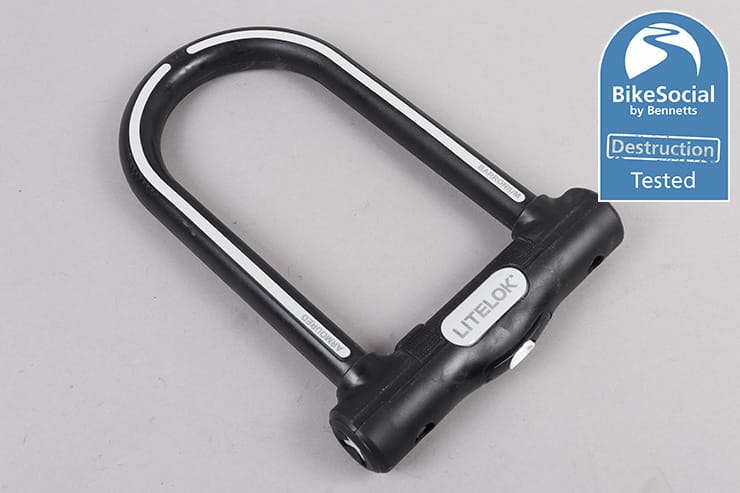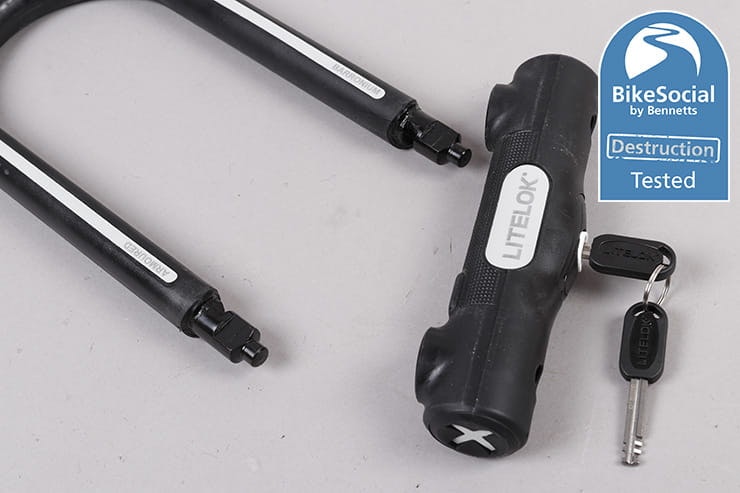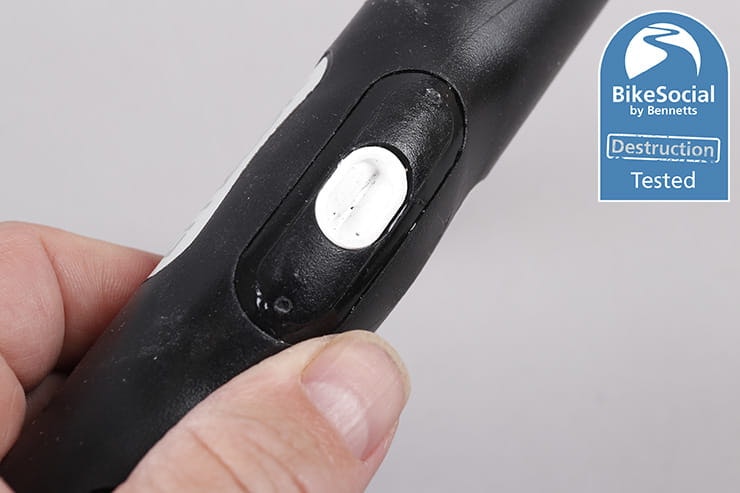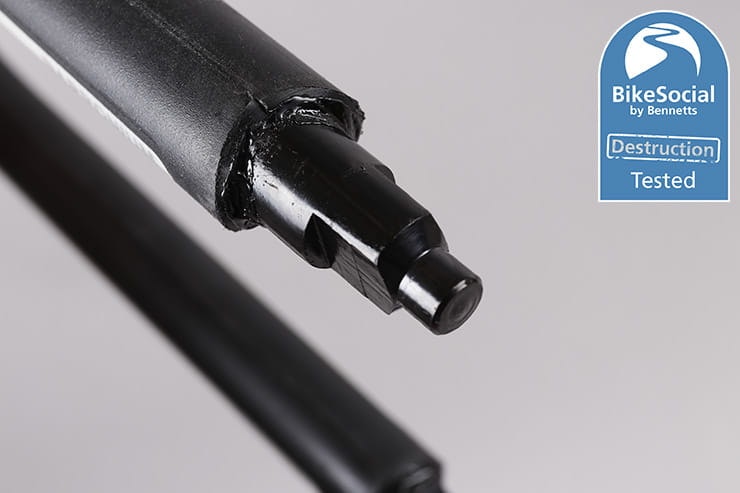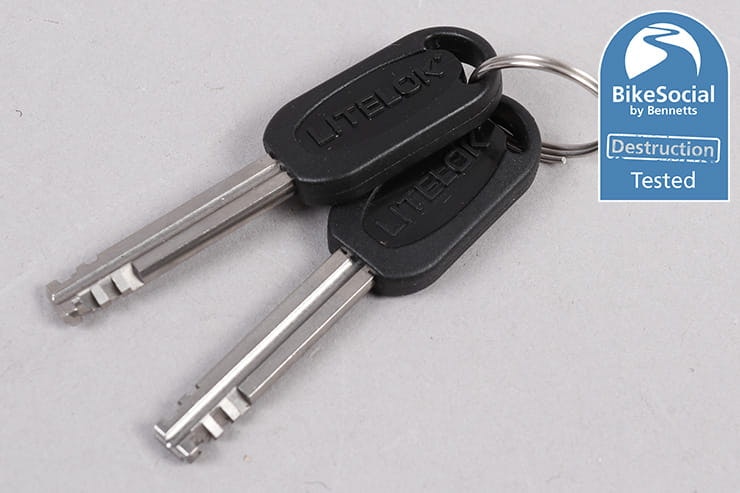Litelok X1 review | Angle-grinder-resistant motorcycle lock tested
By John Milbank
Consumer Editor of Bennetts BikeSocial
10.11.2022
Date reviewed: November 2022 | Tested by: John Milbank | RRP: £149.99 | Weight: 1.73kg | www.litelok.com
The Litelok X1 on review here promises to be the toughest motorcycle lock you can buy thanks to its ‘Barronium’ construction, which resists angle-grinder attacks.
The most common theft of motorcycles often involves no tools; bikes are extremely vulnerable to being pushed away after easily breaking the steering lock, or being lifted into a van. For a thief to ‘go equipped’ they’ll be exposing themselves to more risk of prosecution, but it does of course happen, and the tool of choice is typically the portable angle-grinder.
Before buying any security, as well as checking our in-depth bike lock destruction test reviews here, you should look for Sold Secure approval. This independent body is part of the Master Locksmiths Association, and for chains and locks the Motorcycle Diamond standard is currently the highest achievable. It’s also the only one that includes an angle-grinder attack as locks certified to Motorcycle Gold have not been put through this test by Sold Secure. All of our reviews use this tool though, so you can still compare products to find what’s best for you.
The Litelok X1 is available as a Bike or Moto version, though both offer the same performance and have the same ‘plant-based eco-rubber’ coating to protect paintwork. There’s also a carry bracket supplied, but this is ONLY for bicycle use. A lot of us riders have push-bikes too, so it’s handy that you can get extra value out of this by protecting both.
The X1’s designed to rattle as little as possible, and it is far quieter when shook than the Hiplok D1000. Still, neither can be heard when they’re tucked in my bike’s top-box.
The rubbery coating of the Litelok extends to the lock body, so it doesn’t slide around too much. There are also retro-reflective stickers on the body and shackle, though I’d like to see the option of brightly coloured rubber that’d make the lock more obvious when fitted to warn off thieves and to remind yourself.
Very high resistance to all attacks
Lightest D-lock of this performance
Fits around many motorcycle wheels
Doesn’t fit around ALL motorcycle wheels
I’d like the option of a brightly-coloured lock body
Not the most angle-grinder resistant D-lock
Size and weight
Weighing a measured 1.73kg, the Litelok X1 is a touch lighter than the Hiplok D1000, but a little heavier than some standard D-locks (or U-locks). It can be stored with the body separate, so it might fit under the seat of some bikes, but where it really stands out is in its ability to fit around the front wheel and tyre of many machines.
I tested it on a BMW R1250GS (with spoked wheels), a 1999 Kawasaki ZX-6R and a 2001 Honda VFR 800, and it was only the old Honda’s front wheel that I couldn’t quite get the shackle around.
The shackle’s a slight oval, measuring 21mm at its slimmest and 24mm at the widest. This is small enough that it’ll just about pass through the links of some chains, though I found it helped to trim the coating off at one end of the shackle, which made it much easier to get my portable chain on. With the coating removed, the diameter of the Litelok X1 shackle is 17-18mm.
BMW’s spoked wheels have holes in the hub that this lock easily passes through, making attack of the wheel practically impossible. Attaching around traditional spokes would be pointless, so it’s great that the shackle’s internal dimensions of 101mm x 197mm allow it to pass over the rim and front tyre on some machines. Looping this around cast spokes should not be discounted though, as attacking these is extremely difficult with any tools.
Resistance to attack: bolt-croppers
Unsurprisingly, given that the shackle is up to 18mm thick under the rubbery coating, attack with the largest 42” bolt-cropper was impossible, with barely any marking to the metal.
To see how this compares with the other locks we’ve tested, check out our best motorcycle locks for home and away.
Resistance to attack: drill
Attempting to drill the cylinder out of the lock body was unsuccessful.
To see how this compares with the other locks we’ve tested, check out our best motorcycle locks for home and away.
Resistance to attack: lump hammer
Using an old Triumph Tiger wheel as a test rig, smashing the lock from any angle did nothing more than mar the outer coating.
While the typical use of this lock should always see it kept off the ground, I also laid it on an old section of railway track to act as an anvil, then repeatedly hit it with a sledge-hammer, but this too caused nothing beyond cosmetic damage.
To see how this compares with the other locks we’ve tested, check out our best motorcycle locks for home and away.
Resistance to attack: angle-grinder
All the locks I’ve tested have been attacked with the same mains-powered grinder for consistency, and to allow direct comparison to each other. All that’s changed over the past five years is that I’ve switched from 1.2mm cutting discs to 1.0mm DeWalt Inox discs. This has reduced the time required to cut, but of course I’ve baselined everything to keep each test relevant to the other.
On my first attempt, it took one and a half discs to cut through the Litelok X1 shackle, which exceeds everything I’ve tested except the Hiplok DX1000, Hiplok D1000 and Litelok’s own X3. With the lock off the bike, on another try I managed to get through the shackle with one disc in slightly less time than it takes to cut through a quality 22mm chain. Still a very impressive result for a portable a D-lock.
With one cut, there’s not much rotation at all in the shackle, but it can be pulled apart enough to get it over some slimmer cast spokes and chains. However, if this lock was fitted around the wheel of the bike, it would require two cuts, so at least two discs if you’re lucky.
I did cut through the body of the lock with one and a half discs, but it was more awkward and time consuming than the shackle due to its size.
Attempting to cut the Litelok X1 with a 20V battery-powered grinder, the tool didn’t have enough torque and kept stopping. Any thief will need to have stolen a very high-quality angle-grinder, and will potentially need more than one battery.
I’ve bench-marked my tools against petrol-powered cutters, and there was no advantage.
Note: Bennetts BikeSocial's testing now includes specialist diamond-tipped metal cutting disks, as well as a top-of-the-range DeWalt portable battery-powered grinder. When attacking the Litelok X1 with this device, cut times were reduced and the disc survived. However, it still took significantly longer to cut the lock than a standard D-lock (or U-lock). It's also important to note that police forces are not currently reporting the use of these discs, and that results with them can be very mixed – we've found that abrasive discs still tend to offer the highest speed on most motorcycle security. They are not the 'do-it-all' solution for motorcycle thieves.
A typical theft is carried out using tools stolen from a van, not new ones, but our testing reflects the worst-case scenario of a thief with a full complement of high-quality and well-maintained tool. It's also based on constantly updated reports from the police of what is being used in crime in the UK.
To see how this compares with the other locks we’ve tested, check out our best motorcycle locks for home and away.
Product: Litelok X1
Weight as tested: 1.73kg
Bolt cropper attack: GOOD
Sledge hammer attack: GOOD
Angle grinder attack: OUTSTANDING
Litelok X1 review: Verdict
While Litelok is understandably tight-lipped about how it makes the X1 range, Professor Neil Barron – founder and CEO of Litelok – did tell me that Barronium (see what they did there?) uses a ceramic composite fused to the hardened steel to resist attack. Having cut the shackle and body – both of which use this material – I can say that it definitely works, and that when looking at a cross-section, while the shape shows there’s something special going on, this is clearly a clever process as it really has formed into one piece.
My recommendation would be to use the Litelok X1 around the wheel of your motorcycle, as it will prevent it being pushed away (a very common attack). Then, using a chain through the shackle, the bike can be tied to something, making it impossible to lift into a van. Of course, any portable chain is going to be easier to attack than this lock, but even once that’s cut, thieves still need to get through the lock in order to roll the bike away.
The Litelok X1 might not be the very toughest motorcycle lock on the market, but it strikes a formidable balance between cost and performance. In all practical senses, this is going to stop a thief cutting through it in any kind of reasonable time, and they’ll most likely move onto something else.
To see the other chains and locks tested by Bennetts BikeSocial, click here and be sure to regularly check for the discounts available through BikeSocial membership.
See the Litelok X3 being attack tested
Sledge-hammer, lump-hammer, drill, bolt croppers and angle grinder theft testing
